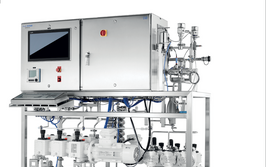
Did you always want to be a scientist?
No! I was a sea scout and I wanted to be a fighter pilot. In school, I was interested in everything and I took all of the advanced classes I could. At university, I started out as a math major, and then progressed to theoretical physics, applied physics, and electronics. I chose my mentoring professor because he competed in offshore sailing, which I liked. He also had an innovative streak to his science that inspired me.
How did you become interested in drug formulation?
My PhD was in applied physics, with a focus on food processing. I then did my MBA in innovation management, before moving abroad to the US. I worked at Harvard Medical School and I was a visiting assistant professor in applied physics at Stanford. When I returned to Finland to the University of Helsinki, I was introduced to Jouko Yliruusi, who was a professor in pharmaceutical technology. He asked if I was interested in working on solutions for poor solubility in pharma.
Stanford had really opened my eyes to academic entrepreneurship. It had a solid commercialization office and it taught me to think about academic breakthroughs as something that could be commercialized. When I returned to Finland, I geared my lab in that direction. Meanwhile, Harvard taught me to work on big problems – and poorly soluble drugs are definitely a big problem in drug development.
So, I said yes to Yliruusi. We combined our expertise in physics and pharmaceutical technology to develop a novel particle engineering technology, which led to the founding of Nanoform. The company was founded using a commercialization grant and I became the CEO. With students and collaborators, I’ve also helped found other start ups too – it’s something I’m really interested in.
What is the technology behind Nanoform?
The technology was inspired by the advanced classes I received in nonlinear thermodynamics. Thermodynamics is usually about linear relationships between pressure, temperature, and density, but when you delve further you learn that you can cheat physics if you use short timescales for processes. This phenomenon has always intrigued me. We used thermodynamics to create nanoparticles using a bottom up approach – because my gut feeling was that it would be better to use a precipitation-like process rather than a grinding process to create nanoparticles.
The technology is called Controlled Expansion of Supercritical Solutions, and is designed to create nanoformulations that offer several benefits, including higher drug loading, improved bioavailability, and better release profiles. Essentially, we use a non-equilibrium thermodynamic process to recrystallize an API in a controlled manner through supercritical carbon dioxide.
As a physicist, the technology is very interesting because it allows me to play with chemistry using a physics-based approach.
Given all the advances made by the industry, why is formulation still so difficult?
The art of cooking is hard, which is why there are so many famous chefs! Pharmaceutical formulation is also hard. Formulated forms, especially at the nanoscale, have very large surface energy gradients and many different physical faces. Even with computation, massive-scale systems are hard to master and understand. We’ve actually been experimenting with AI at Nanoform to control and improve nanoformation, but it’s still not an easy task.
When you are working on a new technology, it has to make a difference in the marketplace and in the patient community – otherwise it's just a gimmick or a Christmas decoration.
How has the company changed since its beginnings?
It has changed through different iterations. For me, the transition from a university lab operation into a startup was definitely a large step from a mental perspective. And now we have become a fully fledged GMP company – which is now listed. We did all of this in four years.
I’m proud of what we have accomplished. At the end of the day, all of this is about patients and ensuring they have the best medicines. We have made a significant contribution to a blockbuster drug (Erleada; apalutamide), and shown we can use our technology to take a product formulated with an amorphous solid dispersion approach and turn it into a superior product.
We’ve worked with a hydrogel product, which has received FDA fast track designation and is now entering the clinic, and we’re now working on a nanotechnology-enhanced formulation of enzalutamide. This project is exciting because it's a big blockbuster product. The current version of this medicine requires cancer patients to take many large pills, but our nanoformulation could reduce that burden to a single tablet. Right now, we're in the process of partnering on the molecule so that it can reach patients in different global markets.
What lies ahead for the company?
The plan is to get more products into the clinic and to patients of course! Both new medicines and improved versions of current products. We recently won a big grant from Business Finland (a government organization) for a nanoparticle-enabled formulation platforms for oral, inhaled, long-acting injectables, high-concentration subcutaneous injectables, and next generation medicines.
And we don’t want to focus solely on small molecules; we want to nanoform mAbs directly into powder forms, without any need for lyophilization. We can increase the concentrations of syringeable solutions without increasing their dynamic viscosity too much. This means that if a patient needs an infusion, they don’t need to sit in the chair for as long.
You also work at the University of Helsinki…
That’s right – I teach classes in ultrasonics and electronics, and I guide students on the topic of academic entrepreneurship. The University of Helsinki is one of the top science universities in Europe. My classes are either senior master or junior PhD classes. Working with the students keeps me intellectually honest, because I have to earn their scientific trust every time I enter the class. I think that keeps my brain sharp; other people do crosswords, I do this!
What traits should a good scientist have?
Intellectual curiosity, discipline, and fearlessness. But, most importantly, you need to be persistent. You cannot be wasting time on TikTok!


















